“Mr. Holmes, they were the footprints of a gigantic hound!”—— Dr. Mortimer (Lionel Atwill) to Sherlock Holmes (Basil Rathbone)
Now, with the 2015 release of Mr. Holmes and a new, if older Sherlock Holmes in Ian McKellen, it seems appropriate to look back seventy-five years, to an earlier, even greater landmark in the screen history of Sir Arthur Conan Doyle’s famous detective character—not as far back, now, as his movie birth, which some scholars believe to have been by an unknown actor in a 1903 half-minute American silent film.
This retrospection, rather, involves the first appearance as Sherlock Holmes, in 1939, of the English actor who, for many, myself included, has come to personify one of the most real of fictional characters. Basil Rathbone, accompanied by his stalwart, overly comical, somewhat unDoylian companion and chronicler Dr. John H. Watson (Nigel Bruce), made his—and their—initial appearance in The Hound of the Baskervilles, the first of two 20th Century-Fox films, later followed by twelve Universal Holmes through 1946.
The superior production value provided by a big studio like 20th Century-Fox is clearly apparent in contrast with the subsequent Universal films. If the ever-dependable fog machine is a frequent method of hiding small or sparse sets, such is not the case here and, besides, the fog adds much to the atmosphere of Hound. The moor set was an amazing 300 by 200 feet. While the scene showing the approach to Baskerville Hall is obviously of a miniature, the interior of the entrance, with its long staircase and ornate fireplace, is quite an impressive set.
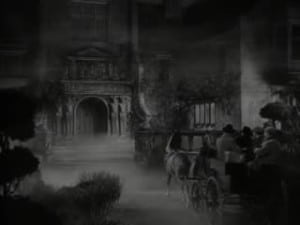 Further assisting the good looks of the screen is the cinematography of the great Leon Shamroy and the direction of another, though less well known American, Sidney Lanfield; his other outstanding film is My Favorite Blond, with Bob Hope and Madeleine Carroll.
Further assisting the good looks of the screen is the cinematography of the great Leon Shamroy and the direction of another, though less well known American, Sidney Lanfield; his other outstanding film is My Favorite Blond, with Bob Hope and Madeleine Carroll.
The musical score by Cyril Mockridge, however, is conspicuously obvious by its absence, little more than main and end titles. Uncredited contributions were supposedly made by David Buttolph and David Raksin, though there is little evidence of what they could have contributed. So, the little bits of romance and kissing, the nighttime prowling about the halls, the suspense of a séance, the struggle with that vicious hound—all is done without musical support.
Rathbone, then forty-seven, was at first regarded by some reviewers as too young to play the detective. True, most of his predecessors in the role had been older—Eille Norwood, Arthur Wontner, John Barrymore, Clive Brook, Reginald Owen and Raymond Massey, among the most famous. In post-Rathbone cinema, the actors would tend to be younger—Peter Cushing, Christopher Lee, John Neville, Robert Stephens and even George C. Scott, who, in They Might Be Giants, does better than most in creating this eccentric and quirky character, though Scott only thinks he is Holmes! The youngest of all is nineteen-year-old Nicholas Rowe, who, earlier in Young Sherlock Holmes, plays even younger.
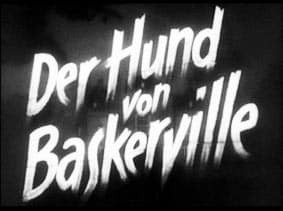 There have been more than two dozen movie, TV and radio versions of the Hound. As far back as 1914, a German version, Der Hund von Baskerville, ran seventy-three minutes and starred Alwin Neuß as Holmes. That aside, the English sound films that are available for viewing include the first-rate 1959 Hound, with Peter Cushing and Andre Morell in the leading roles, and the weak 1972 TV movie attempt starring Stewart Granger and Bernard Fox.
There have been more than two dozen movie, TV and radio versions of the Hound. As far back as 1914, a German version, Der Hund von Baskerville, ran seventy-three minutes and starred Alwin Neuß as Holmes. That aside, the English sound films that are available for viewing include the first-rate 1959 Hound, with Peter Cushing and Andre Morell in the leading roles, and the weak 1972 TV movie attempt starring Stewart Granger and Bernard Fox.
Coming only six years apart were two extreme contrasts in temperament and purpose—first, the 1977 bomb with Peter Cook as Holmes and Dudley Moore as Watson (and three other parts), done for laughs, but pathetic and embarrassing; and, second, the 1983 Hound, with Ian Richardson as a surprisingly effective Holmes, his thin, agile figure similar to Rathbone’s, though he is off screen much of the time. With Donald Churchill as Watson, this is conceivably the best version to date, even superior to the Rathbone, with much more atmosphere. Originally for TV, it is currently available on DVD.
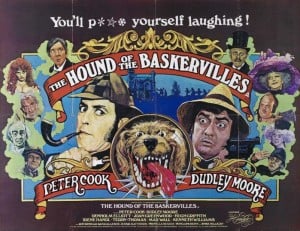 The most famous, enduring and often-filmed of the Holmes adventures, Hound has the simplest of plots, as were all the Doyle stories, whose primary interests and strengths are about crime-solving, insights into the character of Sherlock Holmes and, in all too few instances, scattered throughout the stories, the quite picturesque descriptions of London and the English countryside. It’s true that, as time passed, especially by the 1920s, the crime-solving became less original, more the product of a writer who was dutifully meeting a deadline long after his interest in his Holmes character had waned.
The most famous, enduring and often-filmed of the Holmes adventures, Hound has the simplest of plots, as were all the Doyle stories, whose primary interests and strengths are about crime-solving, insights into the character of Sherlock Holmes and, in all too few instances, scattered throughout the stories, the quite picturesque descriptions of London and the English countryside. It’s true that, as time passed, especially by the 1920s, the crime-solving became less original, more the product of a writer who was dutifully meeting a deadline long after his interest in his Holmes character had waned.
So—the plot:
Sir Charles Baskerville (Ian Maclaren) dies, apparently from fear of something he saw or felt one night while walking the grounds of his estate near the moors of Dartmoor. The family estate is then left to Sir Henry Baskerville (Richard Greene). In an easily dispensable scene not in the novel, a hearing is held into the death, with the introduction of most of the characters to be seen later, including Dr. Mortimer (Lionel Atwill), who testifies that Sir Charles died of a heart attack.
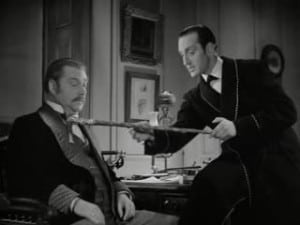 In the next scene, at 221B Baker Street in London, Sherlock Holmes (Rathbone) hands his friend Dr. John Watson (Bruce) the walking stick left by a visitor and asks him what he can deduce from it of its owner. As in another Doyle story, The Blue Carbuncle, in which a black hat is the source of similar analysis, Watson’s deductive skills prove wanting. When Watson asks if anything had escaped him, Holmes replies, “Almost everything, my dear fellow.”
In the next scene, at 221B Baker Street in London, Sherlock Holmes (Rathbone) hands his friend Dr. John Watson (Bruce) the walking stick left by a visitor and asks him what he can deduce from it of its owner. As in another Doyle story, The Blue Carbuncle, in which a black hat is the source of similar analysis, Watson’s deductive skills prove wanting. When Watson asks if anything had escaped him, Holmes replies, “Almost everything, my dear fellow.”
When the cane’s owner, Dr. Mortimer, returns, verifying Holmes’ deductions, he reads the family legend of 1650 and the mysterious death of the distant Sir Hugo Baskerville (complete with seventeenth-century flashbacks, with Ralph Forbes as Hugo). Dr. Mortimer had ominously prefaced the reading: “About fifty yards from where Sir Charles fell dead were the footprints [maybe paw prints?] of a gigantic hound.” He requests Holmes’ help and Holmes agrees.
Dr. Mortimer meets Sir Henry, who has arrived by steamer from Canada. Situations accumulate immediately. First, en route from the wharf, a window in their carriage is smashed by a rock conveying a note warning the new heir to avoid the moor. At the Northumberland Hotel, Sir Henry announces the unusual theft of one of his new shoes; later, that shoe will be returned and replaced with an old shoe. Already, on Holmes’ face there’s that spark of intuition. For the benefit, however, of those standing about, he visibly shrugs off the peculiarity, but he seems to sense that the incidence means something.
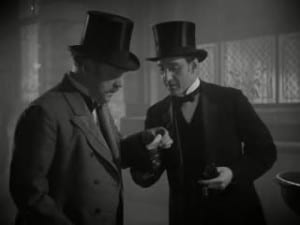 While following Sir Henry and Dr. Mortimer in the street, Holmes and Watson—in top hats—spot a hansom shadowing the heir and his companion—and see a gloved hand and a revolver inch forward from the window of the hansom, á la the extended handgun in both versions of Alfred Hitchcock’s The Man Who Knew Too Much (and, for that matter, the water pistol in Charade). Holmes shouts a warning and the hansom races off, but not before he has written down the number of the cabby.
While following Sir Henry and Dr. Mortimer in the street, Holmes and Watson—in top hats—spot a hansom shadowing the heir and his companion—and see a gloved hand and a revolver inch forward from the window of the hansom, á la the extended handgun in both versions of Alfred Hitchcock’s The Man Who Knew Too Much (and, for that matter, the water pistol in Charade). Holmes shouts a warning and the hansom races off, but not before he has written down the number of the cabby.
In the first of two instances in the film where someone pretends to be Sherlock Holmes, Holmes interviews the cabby (E. E. Clive, a Universal horror film regular), who tells him the occupant of the hansom gave his name as . . . “Sherlock Holmes”!
Holmes begs off accompanying Dr. Mortimer and Sir Henry to Baskerville Hall, saying he has important London business but that Dr. Watson will go instead and keep him posted on events with routine letters.
In a journey in an open carriage over the Devon countryside, Dr. Mortimer describes to his two companions the Dartmoor landscape beyond—the moor, the stone houses built by Neolithic man and the Great Grimpen Mire. “Thousands of lives have been sucked down into its bottomless depths,” he says. “No wonder the people about here have such odd beliefs. Some will tell you that nothing really ever dies upon the moor.”
Almost as grim is dank Baskerville Hall where Sir Henry and Watson meet the nervous butler Barryman and his wife (John Carradine and Eily Malyon), who exchange worried glances and will later will be seen peeking around corners. (The couple’s name in the novel, Barrymore, was changed to avoid confusion with the famous acting family.)
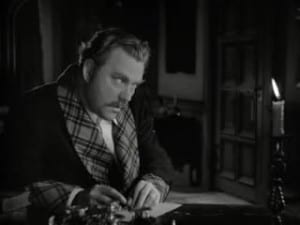 On the first night, as Watson is writing his report to Holmes, he’s interrupted by Sir Henry, who warns that “someone is prowling around” upstairs. Despite the absence of music, the unannounced entry of Sir Henry into Watson’s room is still suspensefully managed, with the traditional turning door handle and a slowly-opening door.
On the first night, as Watson is writing his report to Holmes, he’s interrupted by Sir Henry, who warns that “someone is prowling around” upstairs. Despite the absence of music, the unannounced entry of Sir Henry into Watson’s room is still suspensefully managed, with the traditional turning door handle and a slowly-opening door.
Investigating, they find Barryman with a candle before a window. When the butler leaves, Watson suggests he was signaling someone and lights another candle (conveniently nearby) and raises and lowers it before the window. From across the foggy terrain, a light blinks near the distant crags. On the moor, near one of the monoliths, Sir Henry and Watson find a candle and await the owner’s return. From atop another monolith, a dirty, grizzled man (Nigel De Brulier) throws a rock at the pair. The man flees through the crevices and over the boulders.
On their walk back to the Hall, Sir Henry and Watson hear . . . well, obviously the howl of a wolf or hound, but they hedge admitting it to one another:
“What—what do you think it is?” asks Sir Henry.
“What does it sound like to—to you?”
“Well, if we were back in London . . . this would seem ridiculous.”
“Let’s get on.”
“Look here, doctor, you don’t believe that nonsense, do you?”
“Of course not—no more than you do.”
On the moor the next morning, Sir Henry meets the Stapletons, John (Morton Lowry) and his stepsister, Beryl (Wendy Barrie), and is invited the following night to dine with them and everyone living around the moor.
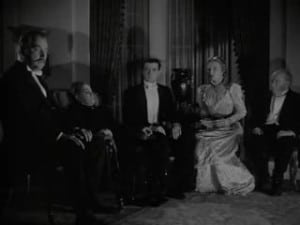 Dr. Mortimer’s wife (Beryl Mercer, who would die before the Hound was released) agrees to a séance (not in the novel). In asking Sir Charles Baskerville what frightened him the night of his death, she fails to call forth his spirit, but, instead, those assembled hear “that sound” again. John Stapleton suggests a bittern, a wading bird of the heron family. Sir Henry claims it’s only the wind. Beryl is frightened. Only Mr. Frankland (Barlowe Borland), whose passion is suing people over trifles, catches on this early: “The hound, of course. Any fool would know that!”
Dr. Mortimer’s wife (Beryl Mercer, who would die before the Hound was released) agrees to a séance (not in the novel). In asking Sir Charles Baskerville what frightened him the night of his death, she fails to call forth his spirit, but, instead, those assembled hear “that sound” again. John Stapleton suggests a bittern, a wading bird of the heron family. Sir Henry claims it’s only the wind. Beryl is frightened. Only Mr. Frankland (Barlowe Borland), whose passion is suing people over trifles, catches on this early: “The hound, of course. Any fool would know that!”
Watson’s next report to Holmes is that there’s nothing new to report, except that he’s convinced Sir Henry is in love with Beryl. Next, the couple horseback ride to High Tor, the site of 50,000-year-old stone huts. When Beryl comments that those long-ago inhabitants are now forgotten, Sir Henry provides a dark moment: “Just as we will be, too, one day.”
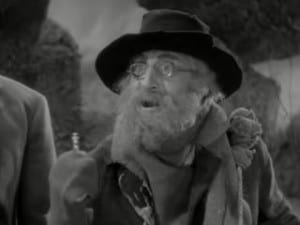 Not only is their first kiss interrupted by the appearance of Watson, to whom Sir Henry announces the couple’s engagement, but by a bent-over old man, in rags, long matted beard and thick spectacles, limping on a cane. He’s a peddler, offering his goods—a mouth organ, a fusel Dr. Watson can use to call his sheep dog, he says, and some “scent” for the lady. As he’s chased away, he mutters, “I ain’t doing no harm. I ain’t doing no harm.”
Not only is their first kiss interrupted by the appearance of Watson, to whom Sir Henry announces the couple’s engagement, but by a bent-over old man, in rags, long matted beard and thick spectacles, limping on a cane. He’s a peddler, offering his goods—a mouth organ, a fusel Dr. Watson can use to call his sheep dog, he says, and some “scent” for the lady. As he’s chased away, he mutters, “I ain’t doing no harm. I ain’t doing no harm.”
Next morning, Watson receives a note, pushed under the door, requesting him to be at a certain stone hut. While Sir Henry is foolishly walking the moor alone and Stapleton shows an unusual curiosity about his movements, Watson enters the specified cave. In the comedy highlight of the film, Watson asks of the peddler when he arrives:
“Who are you?”
“Well, I might ask the same of you, sir . . . ”
“ . . . and if you want to know who I am, I’ll tell you.”
“Who—who are ye?”
“I’m Sherlock Holmes,” boasts Watson.
“Sherlock Holmes, the detective?—”
“Yes, and now perhaps you realize why I can’t be hoodwinked.”
“Oh, sir, sir, sir—that changes everything.”
“Now. Who are you? Quick!”
“Well, in that case, sir”—the peddler abruptly stands erect, unbent—“my name must be Watson. Ha, ha, ha.” He peels off his disguise.
“Holmes!”
“How are you, my dear fellow? A fine detective you are, calling yourself Sherlock Holmes!”
(Between the two 20th Century-Fox and the twelve Universal films, Rathbone has the chance to undergo a number of disguises—a bookseller, an old priest, a surgeon, an aged postman, even an East Indian officer and, the best of all, a music hall singer in The Adventures of Sherlock Holmes.)
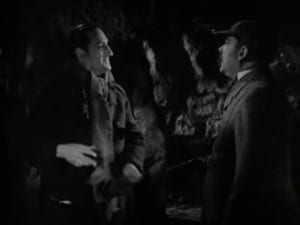 Holmes explains that he’s been in disguise, unwatched, so as to observe the goings-on and has had Watson’s reports forwarded to him. He suggests his imagination, thinking like the criminal, has led him close to a reasonable conclusion about this mystery, that “in another day, or two at the most,” he will know the identity of the murderer of Sir Charles Baskerville.
Holmes explains that he’s been in disguise, unwatched, so as to observe the goings-on and has had Watson’s reports forwarded to him. He suggests his imagination, thinking like the criminal, has led him close to a reasonable conclusion about this mystery, that “in another day, or two at the most,” he will know the identity of the murderer of Sir Charles Baskerville.
As Holmes, now attired in his deerstalker, and Watson walk toward the Hall, they hear and see the hound attack a man, who falls from a high rock. Thinking it’s Sir Henry because of the clothes, they turn the dead man over, only to discover it’s the man who had been signaling from the monoliths. Holmes identifies him as the Notting Hill murder, an escape convict. In earlier scenes, Mrs. Barryman had been seen giving clothes to the man, actually her brother. As Holmes explains to Watson, it was the scent of the clothes, in this case Sir Henry’s discards, that attracted the hound.
When Stapleton walks up, attracted, he says, by a cry, Holmes abruptly says he’s returning to London the next day, explaining that he’s out of his element, that “an investigator needs something more than legends and rumors.”
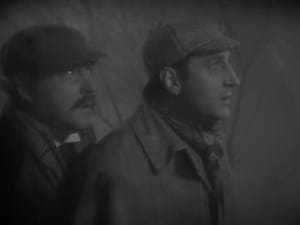 Holmes announces to Sir Henry that now, after the death of the convict, his worries are over, that he and Watson must be off to London. On the train, a confused Watson expresses disbelief in Holmes’ claim that the convict is responsible for the death of Sir Charles. Holmes explains that the real murderer will attempt to kill Sir Henry that night. “Then why are we rushing up to London,” Watson asks, “leaving Sir Henry unprotected?” “We’re not, my dear Watson. We’re just giving the impression of rushing up to London.”
Holmes announces to Sir Henry that now, after the death of the convict, his worries are over, that he and Watson must be off to London. On the train, a confused Watson expresses disbelief in Holmes’ claim that the convict is responsible for the death of Sir Charles. Holmes explains that the real murderer will attempt to kill Sir Henry that night. “Then why are we rushing up to London,” Watson asks, “leaving Sir Henry unprotected?” “We’re not, my dear Watson. We’re just giving the impression of rushing up to London.”
Holmes and Watson race across the moor on foot, their carriage having broken a wheel. Meanwhile, while Sir Henry is leisurely strolling the moor, Stapleton releases the hound from its underground den. The creature attacks Sir Henry, but Holmes and Watson arrive in time to shoot the beast. While Watson takes the injured man back to the Hall, Holmes follows the tracks of the hound, finds its lair and after foolishly dropping into the pit (for the sole purpose, it can only be assumed, of serving the plot!), Stapleton closes and bolts the hatch over him.
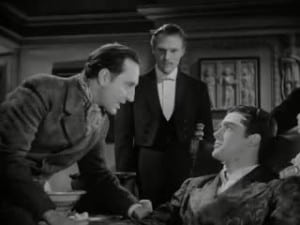 Back at the Hall, Sir Henry is being treated by Watson. Stapleton arrives from the moor and tells the doctor Holmes wants to see him immediately, important—at the place where the hound was killed. While alone with Sir Henry, Stapleton conveniently finds poison—another suspension of logic—in Watson’s medical bag and puts it in a drink. Holmes arrives and intentionally “accidentally” knocks the glass from Sir Henry’s hand before he can drink.
Back at the Hall, Sir Henry is being treated by Watson. Stapleton arrives from the moor and tells the doctor Holmes wants to see him immediately, important—at the place where the hound was killed. While alone with Sir Henry, Stapleton conveniently finds poison—another suspension of logic—in Watson’s medical bag and puts it in a drink. Holmes arrives and intentionally “accidentally” knocks the glass from Sir Henry’s hand before he can drink.
In his dénouement, Holmes explains how Stapleton kept his hound in readiness, giving it the scent of Sir Henry’s worn shoe and releasing it at the right moment. Discovering he is an heir to the Baskerville estate, Stapleton had eliminated Sir Charles and was attempting to kill Sir Henry. From the wall portrait of Sir Hugo Baskerville, it was the eyes and their likeness to Stapleton’s that alerted, perhaps confirmed, Holmes’ suspicions—“The most amazing instance of a throwback that I’ve ever seen.” Stapleton pulls a gun, threatens everyone and flees across the moor. “I posted constables on both the roads,” Holmes says, “and the only other way is across the Grimpen Mire.”
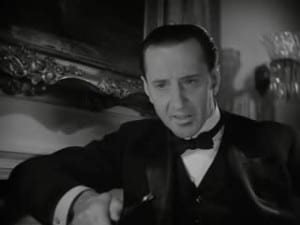 Holmes says he’s had a “strenuous day” and wishes to retire. Hesitating in a doorway, he turns back. “Oh, Watson—the needle.” An amazing line for the movies of that day, referring, of course, to Holmes’ cocaine addiction.
Holmes says he’s had a “strenuous day” and wishes to retire. Hesitating in a doorway, he turns back. “Oh, Watson—the needle.” An amazing line for the movies of that day, referring, of course, to Holmes’ cocaine addiction.
Made the same year by 20th Century-Fox after the success of Hound, the sequel, The Adventures of Sherlock Holmes, is an even better film, a better mystery, with more clues and an even more dynamic, incisive and alert Rathbone as Holmes. Small point that the mystery is not based on a Doyle story. Bruce and Shamroy would return, as would Mockridge, now with a full-fledged film score, emphasizing all the more its desperate need in Hound.
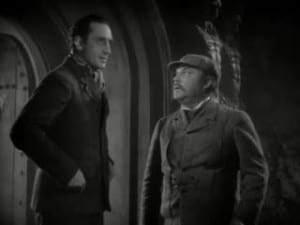 In the later Universal films, Rathbone would now be accused, not of being too young, or even too old, but of “walking through” the role of Sherlock Holmes, by which time his enthusiasm for the character had waned, much as Doyle’s had in writing the adventures. Rathbone’s interest also eventually faded for the Holmes mysteries on radio, featuring Bruce and running 1939-1946; he opted out and was replaced by Tom Conway and he by John Stanley.
In the later Universal films, Rathbone would now be accused, not of being too young, or even too old, but of “walking through” the role of Sherlock Holmes, by which time his enthusiasm for the character had waned, much as Doyle’s had in writing the adventures. Rathbone’s interest also eventually faded for the Holmes mysteries on radio, featuring Bruce and running 1939-1946; he opted out and was replaced by Tom Conway and he by John Stanley.
When Rathbone is at his best, whether as Captain Levasseur in Captain Blood, Sir Guy of Gisbourne in The Adventures of Robin Hood, Captain Esteban Pasquale in The Mark of Zorro—the actor is, after all, one of the great screen villains—or as Sherlock Holmes, he is always a joy to watch.
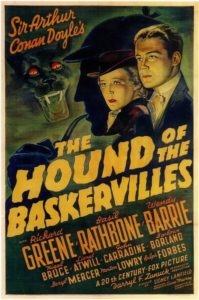
My childhood in the early 1940s was centered about a massive tome, the Complete Sherlock Holmes,augmented by the Silver Screen’s duo and Petrie Wines radio offerings captured by a home brew crystal set!
A CLASSIC1 the 1939 film is a
motion picture!